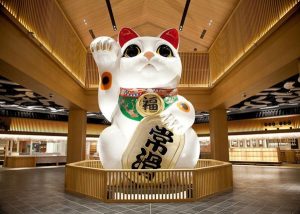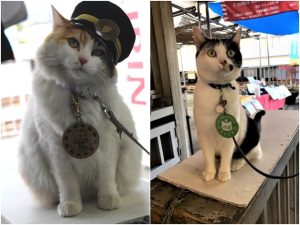Throughout history, cats have often been viewed as symbols of good fortune and divine favour. The ancient Egyptians revered the cat goddess Bastet as the bringer of fertility and protector of the king; the Greeks and Romans also incorporated cats into their belief systems, associating them with the goddesses Artemis and Diana. In Scandinavia, Norse mythology had cats pulling the chariot of the goddess Freya; farmers would leave out milk in their fields to please Freya’s companions and seek her protection for their crops. In Japan, the legend of the Maneki-Neko (lit. Beckoning Cat) says that a cat made an arm motion to a passing merchant who approached the feline and avoided getting struck by lightning. Cats have been cherished pets across the world for centuries, with many cultures embracing them for their pest-hunting abilities. The first record of the domestication of cats comes from Ancient Egypt, where cats were even mummified alongside human owners in a sign of respect and reverence. In Song Dynasty China, cats with white and yellow fur were called lion cats and treasured as domestic companions simply because people found them to be too darn cute. In the year 889, the Japanese Emperor Uda—who had received a black cat, originally meant as a gift for his father—wrote this in his diary:
“The colour of the fur is peerless. None could find the words to describe it, although one said it was reminiscent of the deepest ink. It has an air about it, similar to Kanno. Its length is 5 sun, and its height is 6 sun. I affixed a bow about its neck, but it did not remain for long. In rebellion, it narrows its eyes and extends its needles. It shows its back. When it lies down, it curls in a circle like a coin. You cannot see its feet. It’s as if it were a circular Bi disc. When it stands, its cry expresses profound loneliness, like a black dragon floating above the clouds. By nature, it likes to stalk birds. It lowers its head and works its tail. It can extend its spine to raise its height by at least 2 suns. Its colour allows it to disappear at night. I am convinced it is superior to all other cats.”

It is no surprise then that a stray calico cat managed to turn the fortunes of a Japanese train station around, becoming a legend in the process. Tama Daimyojin, the Eternal Goddess-Stationmaster of Kishi Station Tama, a calico cat, was born on April 29th, 1999, in the Japanese city of Kinokawa. She lived with a group of strays near the town’s Kishi Railway Station and was cared for by well-meaning passengers and the stationmaster. In 2004, the company running the station—Nankai Electric Railway—was in financial trouble and ordered the closure of Kishi station. In 2006, the station and its train line were taken over by the newly formed Wakayama Electric Railway (WER), but the construction of a new road made the company evict Tama and the other strays from their shelter.The stationmaster pleaded with the company’s president to let him house the cats in the station; the president saw Tama as a maneki-neko and approved the request.
In January of 2007, in what was likely good-natured humour, WER appointed Tama as the stationmaster at Kishi, giving her a specially made hat, a golden name tag, and an annual salary of cat food. News of the appointment spread across the country, and tourists began flocking to Kishi Station for a meeting with the new stationmaster. The impact was immediate; the only train line serving Kishi, having seen a consistent annual decline of 5% in passenger numbers earlier, saw a 10% increase in the very first year, with ridership and allied merchandise sales amounting to increased annual revenue of USD 10 million.In 2008, Tama was given a promotion and an office with an ensuite bathroom; the same year, she was knighted by the Governor of Wakayama Prefecture in recognition of her services in promoting tourism.

The next year, a special Tama Train was introduced on the line running to Kishi Station, and in 2010 Tama was made part of the company’s corporate management as an operating officer, making her the only female management employee of the company at the time; at the same time, Tama’s home station was rebuilt with the additional revenue she brought in, and the new design was made to resemble a cat’s face. In 2011, Tama was made Managing Executive Officer—third in the company’s chain of command after the President and Managing Director—and in 2013 she was made Honorary President of the Wakayama Electric Railway for life. An ageing Tama then worked a reduced workweek of four days instead of the six days she had worked without a break for six years.

On the 22nd of June 2015, Tama passed away from heart failure at a hospital in Wakayama prefecture. Thousands from across Japan came to pay homage to the Eternal Stationmaster of Kishi—a title given to Tama posthumously—and the company president led her funeral and personally chose stones for her memorial from the area where she was born. A fifty-day mourning period was observed by WER, during which the Tama train was redecorated in memoriam. In August of that year, Tama was declared a spirit goddess and was enshrined at the Tama Jinja (Tama Shrine) next to Kishi Station.


The shrine has a bronze statue of Tama and a memorial plaque with calligraphy from WER President Mitsunobu Kojima. Tama was succeeded by Nitama (Tama II), who was rescued from under a train at a nearby station and had trained at Idakiso Station before becoming Tama’s apprentice. Nitama currently serves as stationmaster at Kishi station, while her understudy Yontama (Tama IV) serves at Idakiso in a similar capacity; both make annual visits to Tama jinja to pay their respects on Tama’s death anniversary. Gotama (Tama V), an 8-month-old kitten, joined the team in January of this year and splits her time between Kishi and Idakiso stations.

And you may be wondering; the math isn’t adding up on those successors, and you’d be right. Santama (Tama III) was sent to train at a station in Okayama Prefecture and was expected to return to Kishi as part of Tama’s successor. The host station, however, fell in love with her and refused to send her back. The press secretary, who had been caring for her, said,
“I will not let go of this child; she will stay in Okayama.”
As of 2018, Santana is stationmaster at the station in Naka-ku, Okayama City.
















